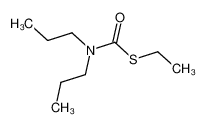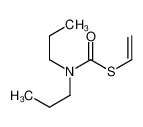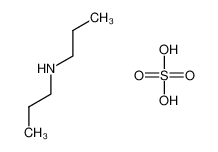1.Identification
1.1 GHS Product identifier
| Product name | EPTC |
|---|
1.2 Other means of identification
| Product number | - |
|---|---|
| Other names | S-Ethyl-N,N-dipropylthiocarbamate |
1.3 Recommended use of the chemical and restrictions on use
| Identified uses | For industry use only. Herbicide |
|---|---|
| Uses advised against | no data available |
1.4 Supplier's details
| Company | MOLBASE (Shanghai) Biotechnology Co., Ltd. |
|---|---|
| Address | Floor 4 & 5, Building 12, No. 1001 North Qinzhou Road, Xuhui District, Shanghai, China |
| Telephone | +86(21)64956998 |
| Fax | +86(21)54365166 |
1.5 Emergency phone number
| Emergency phone number | +86-400-6021-666 |
|---|---|
| Service hours | Monday to Friday, 9am-5pm (Standard time zone: UTC/GMT +8 hours). |
2.Hazard identification
2.1 Classification of the substance or mixture
Acute toxicity - Oral, Category 4
2.2 GHS label elements, including precautionary statements
| Pictogram(s) |  |
|---|---|
| Signal word | Warning |
| Hazard statement(s) | H302 Harmful if swallowed |
| Precautionary statement(s) | |
| Prevention | P264 Wash ... thoroughly after handling. P270 Do not eat, drink or smoke when using this product. |
| Response | P301+P312 IF SWALLOWED: Call a POISON CENTER/doctor/…if you feel unwell. P330 Rinse mouth. |
| Storage | none |
| Disposal | P501 Dispose of contents/container to ... |
2.3 Other hazards which do not result in classification
none
3.Composition/information on ingredients
3.1 Substances
| Chemical name | Common names and synonyms | CAS number | EC number | Concentration |
|---|---|---|---|---|
| EPTC | EPTC | 759-94-4 | none | 100% |
4.First-aid measures
4.1 Description of necessary first-aid measures
General advice
Consult a physician. Show this safety data sheet to the doctor in attendance.
If inhaled
Fresh air, rest. Refer for medical attention.
In case of skin contact
Remove contaminated clothes. Rinse and then wash skin with water and soap.
In case of eye contact
First rinse with plenty of water for several minutes (remove contact lenses if easily possible), then refer for medical attention.
If swallowed
Rinse mouth. Rest. Refer for medical attention .
4.2 Most important symptoms/effects, acute and delayed
SYMPTOMS: Symptoms of exposure to this compound may include headache, giddiness, nervousness, blurred vision, weakness, nausea, cramps, diarrhea, sweating, miosis, tearing, salivation, vomiting and cyanosis.
4.3 Indication of immediate medical attention and special treatment needed, if necessary
Absorption, Distribution and Excretion
ROOT ABSORPTION OF EPTC WAS REPORTED ... IN OAT ... & IN ALFALFA. THE ABSORBED EPTC WAS READILY MOVED UPWARD TO THE FOLIAGE. THIS CHEMICAL IS ALSO ABSORBED BY THE COLEOPTILES & CAN BE TRANSLOCATED DOWNWARD TO THE ROOTS. ... THE RADIOSULFURFROM LABELED EPTC ACCUMULATES IN GROWING STEM & ROOT TIPS AFTER THE APPLICATION TO THE LEAVES. WHEN THE APPLICATION WAS MADE TO THE ROOTS, THE DISTRIBUTION WAS MORE UNIFORM.
5.Fire-fighting measures
5.1 Extinguishing media
Suitable extinguishing media
Fires involving this compound should be controlled with a dry chemical, carbon dioxide or Halon extinguisher.
5.2 Specific hazards arising from the chemical
Flash point data are not available for this chemical, but it is probably combustible.
5.3 Special protective actions for fire-fighters
Wear self-contained breathing apparatus for firefighting if necessary.
6.Accidental release measures
6.1 Personal precautions, protective equipment and emergency procedures
Use personal protective equipment. Avoid dust formation. Avoid breathing vapours, mist or gas. Ensure adequate ventilation. Evacuate personnel to safe areas. Avoid breathing dust. For personal protection see section 8.
6.2 Environmental precautions
Do NOT wash away into sewer. Collect leaking and spilled liquid in sealable containers as far as possible. Absorb remaining liquid in sand or inert absorbent. Then store and dispose of according to local regulations.
6.3 Methods and materials for containment and cleaning up
Pick up and arrange disposal. Sweep up and shovel. Keep in suitable, closed containers for disposal.
7.Handling and storage
7.1 Precautions for safe handling
Avoid contact with skin and eyes. Avoid formation of dust and aerosols. Avoid exposure - obtain special instructions before use.Provide appropriate exhaust ventilation at places where dust is formed. For precautions see section 2.2.
7.2 Conditions for safe storage, including any incompatibilities
Provision to contain effluent from fire extinguishing. Separated from food and feedstuffs. Ventilation along the floor.... Indefinite storage life under normal ambient conditions.
8.Exposure controls/personal protection
8.1 Control parameters
Occupational Exposure limit values
no data available
Biological limit values
no data available
8.2 Appropriate engineering controls
Handle in accordance with good industrial hygiene and safety practice. Wash hands before breaks and at the end of workday.
8.3 Individual protection measures, such as personal protective equipment (PPE)
Eye/face protection
Safety glasses with side-shields conforming to EN166. Use equipment for eye protection tested and approved under appropriate government standards such as NIOSH (US) or EN 166(EU).
Skin protection
Wear impervious clothing. The type of protective equipment must be selected according to the concentration and amount of the dangerous substance at the specific workplace. Handle with gloves. Gloves must be inspected prior to use. Use proper glove removal technique(without touching glove's outer surface) to avoid skin contact with this product. Dispose of contaminated gloves after use in accordance with applicable laws and good laboratory practices. Wash and dry hands. The selected protective gloves have to satisfy the specifications of EU Directive 89/686/EEC and the standard EN 374 derived from it.
Respiratory protection
Wear dust mask when handling large quantities.
Thermal hazards
no data available
9.Physical and chemical properties
| Physical state | light yellow liquid |
|---|---|
| Colour | Colorless liquid |
| Odour | Aromatic odor |
| Melting point/ freezing point | no data available |
| Boiling point or initial boiling point and boiling range | 127ºC (20 torr) |
| Flammability | Combustible. Liquid formulations containing organic solvents may be flammable. Gives off irritating or toxic fumes (or gases) in a fire. |
| Lower and upper explosion limit / flammability limit | no data available |
| Flash point | 116ºC |
| Auto-ignition temperature | no data available |
| Decomposition temperature | no data available |
| pH | no data available |
| Kinematic viscosity | no data available |
| Solubility | less than 0.1 mg/mL at 22.5°C |
| Partition coefficient n-octanol/water (log value) | log Kow = 3.21 |
| Vapour pressure | 0.034 mm Hg at 35°C |
| Density and/or relative density | 0.95 |
| Relative vapour density | (air = 1): 6.5 |
| Particle characteristics | no data available |
10.Stability and reactivity
10.1 Reactivity
no data available
10.2 Chemical stability
Stable under storage conditions.
10.3 Possibility of hazardous reactions
ETHYL DIPROPYLTHIOCARBAMATE may generate flammable gases with aldehydes, nitrides, and hydrides. Incompatible with acids, peroxides, and acid halides.
10.4 Conditions to avoid
no data available
10.5 Incompatible materials
no data available
10.6 Hazardous decomposition products
When heated to decomposition it emits very toxic fumes of /nitrogen oxides and sulfur oxides/.
11.Toxicological information
Acute toxicity
- Oral: LD50 Rat male albino oral 2550 mg/kg
- Inhalation: no data available
- Dermal: no data available
Skin corrosion/irritation
no data available
Serious eye damage/irritation
no data available
Respiratory or skin sensitization
no data available
Germ cell mutagenicity
no data available
Carcinogenicity
Cancer Classification: Not Likely to be Carcinogenic to Humans
Reproductive toxicity
no data available
STOT-single exposure
no data available
STOT-repeated exposure
no data available
Aspiration hazard
no data available
12.Ecological information
12.1 Toxicity
- Toxicity to fish: LC50 Salmo gairdneri (Rainbow trout) 19 ppm/96 hr /Conditions of bioassay not specified/ /Technical eptam
- Toxicity to daphnia and other aquatic invertebrates: no data available
- Toxicity to algae: no data available
- Toxicity to microorganisms: no data available
12.2 Persistence and degradability
AEROBIC: Radio-labeled eptam (initial concn of 2 ppm) was incubated at 25°C and pH 5.3 in sludge- and manure-amended soils; after a 60 day test period, 65-66 and 62-65% 14C-carbon dioxide evolution was observed, respectively(1). In a heavy silt loam, heavy silt and fine sandy loam which all had 3-4 yrs previous exposure to eptam, about 100% (initial concn not given) degradation was observed after 12-15 days. In the same time period, about 10-20% loss of eptam was noted in sterile soil samples(2); this may have been due to volatilization. In a heavy silt loam, heavy silt and fine sandy loam which had no previous exposure to eptam, about 100%, 20% and 20% (initial concn not given) degradation was observed after 12, 15 and 15 days, respectively(2). In a sandy loam soil (pH 6) incubated at 28°C, 93% and 68% carbon dioxide production was observed after 30 days for concns of 150 and 1500 ppm eptam(3). Laboratory tests to measure the aerobic soil degradation rates of eptam indicated half-lives of 36 to 75 days(4). The rate of eptam degradation decreases with time(4).
12.3 Bioaccumulative potential
The bioaccumulation and elimination of 14C-EPTC by bluegill sunfish was investigated in a dynamic flow-through system, where the fish were exposed for 28 days to radiolabeled 14C-eptam at 22°C, followed by depuration in EPTC free water for 14 days(1). Bioconcentration factors were 37, 60, and 110, respectively, in the edible, whole fish, and non-edible fish tissues(1). According to a classification scheme(2), the whole-fish BCF value suggests the potential for bioconcentration in aquatic organisms is moderate(SRC).
12.4 Mobility in soil
The avg Koc of eptam is 200; and measured values of Koc range from 170-280(1). Experimentally-determined Kocs are: 283 in soil with 1.0-4.5% organic content and 109 in soil with 30% organic content(2). Koc values for eptam were measured for 4 soil series with various organic matter (OM%) levels(1): e.g., Atterberry (2.2%), Columbia (1.1%), Keeton (0.3%), and Sorrento (1.8%); the Koc values were 136, 146, 264, and 143, respectively(3). According to a classification scheme(4), these Koc values suggest that eptam is expected to have moderate to high mobility in soil(SRC). Eptam has low affinity for binding to soil suggesting a potential to leach to groundwater(3).
12.5 Other adverse effects
no data available
13.Disposal considerations
13.1 Disposal methods
Product
The material can be disposed of by removal to a licensed chemical destruction plant or by controlled incineration with flue gas scrubbing. Do not contaminate water, foodstuffs, feed or seed by storage or disposal. Do not discharge to sewer systems.
Contaminated packaging
Containers can be triply rinsed (or equivalent) and offered for recycling or reconditioning. Alternatively, the packaging can be punctured to make it unusable for other purposes and then be disposed of in a sanitary landfill. Controlled incineration with flue gas scrubbing is possible for combustible packaging materials.
14.Transport information
14.1 UN Number
| ADR/RID: UN2902 | IMDG: UN2902 | IATA: UN2902 |
14.2 UN Proper Shipping Name
| ADR/RID: PESTICIDE, LIQUID, TOXIC, N.O.S. |
| IMDG: PESTICIDE, LIQUID, TOXIC, N.O.S. |
| IATA: PESTICIDE, LIQUID, TOXIC, N.O.S. |
14.3 Transport hazard class(es)
| ADR/RID: 6.1(b) | IMDG: 6.1(b) | IATA: 6.1(b) |
14.4 Packing group, if applicable
| ADR/RID: III | IMDG: III | IATA: III |
14.5 Environmental hazards
| ADR/RID: no | IMDG: no | IATA: no |
14.6 Special precautions for user
no data available
14.7 Transport in bulk according to Annex II of MARPOL 73/78 and the IBC Code
no data available
15.Regulatory information
15.1 Safety, health and environmental regulations specific for the product in question
| Chemical name | Common names and synonyms | CAS number | EC number |
|---|---|---|---|
| EPTC | EPTC | 759-94-4 | none |
| European Inventory of Existing Commercial Chemical Substances (EINECS) | Listed. | ||
| EC Inventory | Listed. | ||
| United States Toxic Substances Control Act (TSCA) Inventory | Listed. | ||
| China Catalog of Hazardous chemicals 2015 | Not Listed. | ||
| New Zealand Inventory of Chemicals (NZIoC) | Not Listed. | ||
| Philippines Inventory of Chemicals and Chemical Substances (PICCS) | Not Listed. | ||
| Vietnam National Chemical Inventory | Not Listed. | ||
| Chinese Chemical Inventory of Existing Chemical Substances (China IECSC) | Not Listed. | ||
16.Other information
Information on revision
| Creation Date | Aug 17, 2017 |
|---|---|
| Revision Date | Aug 17, 2017 |
Abbreviations and acronyms
- CAS: Chemical Abstracts Service
- ADR: European Agreement concerning the International Carriage of Dangerous Goods by Road
- RID: Regulation concerning the International Carriage of Dangerous Goods by Rail
- IMDG: International Maritime Dangerous Goods
- IATA: International Air Transportation Association
- TWA: Time Weighted Average
- STEL: Short term exposure limit
- LC50: Lethal Concentration 50%
- LD50: Lethal Dose 50%
- EC50: Effective Concentration 50%
References
- IPCS - The International Chemical Safety Cards (ICSC), website: http://www.ilo.org/dyn/icsc/showcard.home
- HSDB - Hazardous Substances Data Bank, website: https://toxnet.nlm.nih.gov/newtoxnet/hsdb.htm
- IARC - International Agency for Research on Cancer, website: http://www.iarc.fr/
- eChemPortal - The Global Portal to Information on Chemical Substances by OECD, website: http://www.echemportal.org/echemportal/index?pageID=0&request_locale=en
- CAMEO Chemicals, website: http://cameochemicals.noaa.gov/search/simple
- ChemIDplus, website: http://chem.sis.nlm.nih.gov/chemidplus/chemidlite.jsp
- ERG - Emergency Response Guidebook by U.S. Department of Transportation, website: http://www.phmsa.dot.gov/hazmat/library/erg
- Germany GESTIS-database on hazard substance, website: http://www.dguv.de/ifa/gestis/gestis-stoffdatenbank/index-2.jsp
- ECHA - European Chemicals Agency, website: https://echa.europa.eu/










